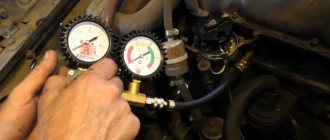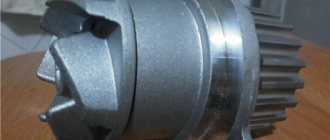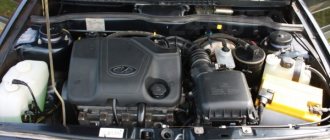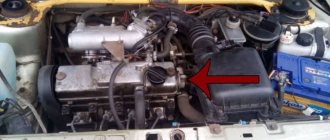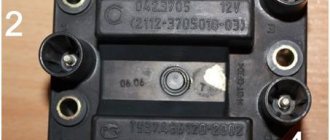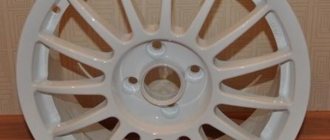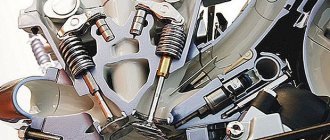Invalid compression values for the engine
At first glance, it may seem that the higher the compression parameters of the air-combustible mixture, the better. But actually it is not. Compression has an upper threshold that cannot be crossed, as this will lead to overheating of the engine, and, as a result, deposits of carbon deposits, excessive load on the pistons and rings, as a result of which engine parts may fail.
Low pressure in the engine leads to excessive consumption of fuel and oil. It is not permissible that in individual cylinders it differs sharply from neighboring ones. Different compression in the cylinders indicates serious problems in the engine - wear and defects that have appeared that require replacement or repair of parts.
Thus, bad compression is:
- increased,
- low,
- different.
All of these signs of poor compression are a sign that the heart of the car needs repair.
CORRECT COMPRESSION
How much compression should be in the engine for its long-term and trouble-free operation? Long-term practice of operating cars shows that ideally it should be 14 barrels in each cylinder. But a reduction to 11 barrels is allowed, provided that the difference in compression in the cylinders should be no more than 1 barrel. For example, a compression pattern of 11-12-11-12 is considered acceptable, but if the pressure in different cylinders is 11-12-11-9, or another combination of indicators that differs from normal, then the engine already needs repair.
What compression should be on a VAZ 2114 8 valve also depends on how long and under what conditions the car is operated. Ideal pressure, as a rule, occurs with a new engine, or one that has just come out of a major overhaul. During vehicle operation, compression may drop by 1-2 barrels. And this will also be within the normal range.
A new engine is the key to good pressure
What should be the compression in the engine?
How much compression should be in the engine for its long-term and trouble-free operation? Long-term practice of operating cars shows that ideally it should be 14 barrels in each cylinder. But a reduction to 11 barrels is allowed, provided that the difference in compression in the cylinders should be no more than 1 barrel. For example, a compression pattern of 11-12-11-12 is considered acceptable, but if the pressure in different cylinders is 11-12-11-9, or another combination of indicators that differs from normal, then the engine already needs repair.
What compression should be on a VAZ 2114 8 valve also depends on how long and under what conditions the car is operated. Ideal pressure, as a rule, occurs with a new engine, or one that has just come out of a major overhaul. During vehicle operation, compression may drop by 1-2 barrels. And this will also be within the normal range.
Ways to increase compression
A decrease in compression does not always mean the need for a major engine overhaul. After all, it can arise for other reasons. Many of them can be eliminated with your own hands. To do this you need:
- Replace the air filter and spark plugs if they are in poor condition and have been changed for a long time.
- Adjust the valves;
- Replace oil rings. You can do this yourself by first assessing the condition of the old elements;
- Replace or correctly install the timing belt. This procedure is described in the article Timing timing marks on the VAZ 2114. Decarbonize the engine. Chemicals are used for this. They can be bought at any auto store. The composition is poured into the engine in accordance with the instructions. The chemical must remove carbon deposits and other contaminants on the engine walls. This will help him restore stable work.
Most operations can be done with your own hands. But, if they cause difficulties, it is recommended to contact a car service. If the above procedures do not work, the engine is likely very worn and needs a major overhaul. This usually happens with very high mileage or with insufficient engine care. In this case, you need to contact a service station to carry out capital repairs. Such repairs are not cheap, and timely maintenance of the car and elimination of minor faults will help to avoid it.
What causes too high compression?
Let's look at the main reasons:
- Incorrect adjustment of the timing belt leads not only to increased compression, but also to decreased compression, depending on the direction of regulation.
- The appearance of scale on the valves, which appears due to the use of low-quality gasoline, oil or other automotive chemicals. Carbon deposits on the throttle assemblies and in the combustion chamber also appear due to engine overheating. Thus, overheating of the internal combustion engine is not only a consequence, but also a cause of high pressure of the air-combustible mixture. The operating temperature of the VAZ 2114 8 valve engine should not exceed 85-90°C.
- High compression can be caused by stuck oil seals. This reason is not difficult to detect. You just need to unscrew the spark plugs and inspect the cylinders. The appearance of an oil film on their walls will indicate an excess of oil in them, and the need to change the caps.
Compression is also affected by the level of oil pressure in the engine. If it is too high, then this leads to increased pressure of the air-combustible mixture.
Low pressure occurs if the rings are worn out or the valves are burnt out. The operating temperature of the engine also affects. If it is below normal, this will also affect the pressure of the air-combustible mixture.
The reasons for the lack of compression in the engine lie in improper operation and untimely preventive repairs. Sometimes air breaks through from several sides at once - for example, through valves, and at the same time through pistons with rings. Then the pressure disappears completely. It's simply not acceptable to let the car get into this state.
Normal compression and its deviations
General cylinder diagram
According to generally accepted standards, the compression of the VAZ 2114 8 valves should ideally be 14 bars (almost 14 atmospheres). The maximum permissible deviation to the lower side is 3 bars (that is, the compression value should not be lower than 11 bar).
True, this is only allowed if the compression value in different cylinders differs by no more than 1 bar. That is, the following compression schemes are acceptable in four cylinders: 12-12-11-12, 12-11-12-11 and so on. If the pressure difference exceeds 1 bar, then such an engine must be urgently repaired.
For example: 11-14-12-8.
Also, it should be remembered that increased compression is no less evil than low compression or compression with a large variation in the cylinders. Thus, increased pressure in the cylinders of the VAZ 2114 can cause high load on engine components, deposit of carbon deposits on the cylinder walls, and ultimately lead to complete engine failure.
Thus, the normal compression should be in the range from 14 to 11 bar, and have a variation from cylinder to cylinder of no more than 1 bar.
In most cases, only new engines have an ideal compression of 14 atm. Even after short-term use, it can quickly drop by 1-2 units - this is considered quite normal. With further wear, it will begin to sag even more, and the wear itself will proceed differently in all cylinders, which will ultimately lead to a large variation in pressure in them.
How to measure compression correctly
Engine compression is measured with a fully charged battery. After charging and installing the power source in place, check the starter. It shouldn't create any problems either. Then warm up the engine. Its temperature during measurements should be 70-90°C.
It is necessary to unscrew all spark plugs from all holes. Also unscrew the fuel hose to stop the fuel supply. Prepare the compression gauge for use.
Compressometer
PREPARATION FOR MEASUREMENTS
Engine compression is measured with a fully charged battery. After charging and installing the power source in place, check the starter. It shouldn't create any problems either. Then warm up the engine. Its temperature during measurements should be 70-90 O C.
It is necessary to unscrew all spark plugs from all holes. Also unscrew the fuel hose to stop the fuel supply. Prepare the compression gauge for use.
Compressometer
How to measure compression with a compression meter
A device consisting of a pressure gauge and a rubberized tube that measures compression in the engine is called a compression gauge.
The following devices are used:
- clamping,
- universal,
- flexible,
- threaded
Experts believe that of all types of compression gauges, it is better to use threaded ones. They provide more accurate information. It is necessary to measure the compression in the engine in each cylinder separately. The measuring instrument hose is inserted into the spark plug socket.
Now that everything is ready for measurements, start the engine and squeeze the gas all the way, let the engine run for a while. Check the pressure gauge readings and record them. Move the compression tester hose to the next spark plug hole, and take measurements in the second and subsequent cylinders in the same way. Write down all the results and compare them.
COMPRESSION MEASUREMENTS IN THE ENGINE. COMPRESSOMETER
A device consisting of a pressure gauge and a rubberized tube that measures compression in the engine is called a compression gauge. The following devices are used:
Experts believe that of all types of compression gauges, it is better to use threaded ones. They provide more accurate information. It is necessary to measure the compression in the engine in each cylinder separately. The measuring instrument hose is inserted into the spark plug socket.
Now that everything is ready for measurements, start the engine and squeeze the gas all the way, let the engine run for a while. Check the pressure gauge readings and record them. Move the compression tester hose to the next spark plug hole, and take measurements in the second and subsequent cylinders in the same way. Write down all the results and compare them.
What should the compression be in an injection engine?
Below you will learn how to correctly measure compression in a VAZ 2114 engine with injection type power.
If in at least one cylinder the pressure gauge shows a pressure below 10 barrels, then we need to look for the reason for such a low indicator. Otherwise, very soon it will fall in other cylinders.
Fill a medical syringe with about 10 milligrams of oil and spray it into the cylinder. Take the measurement again. If the pressure gauge readings increase, it means the piston rings are worn out and require replacement. If it remains at the same low level, then it is necessary to adjust the clamped valves or replace the burnt valves.
Compression rate in the VAZ 2114 engine
Compression of a VAZ 2114 engine is the value of piston pressure at maximum compression of the working mixture. It can be normal, increased or decreased. This value depends on many factors and is measured in bars.
Normal compression in a VAZ 2114 engine is 14 bar . A decrease of no more than 3 bars is permissible. Moreover, it should be the same in all cylinders. Only a slight deviation of one bar is possible. Otherwise, immediate diagnosis and engine repair is required.
How to measure compression without a compression gauge
Is it possible to measure compression without a device? Practice shows that yes, it is possible. But this method will give relative and approximate readings. To measure the compression indicator without instruments, remove the spark plugs from all cylinders except the one being tested. Manually rotate the crankshaft until the compression stroke ends (watch the marks - they should match). Perform this operation on all cylinders one by one. Where the pressure is low, it will take less effort to turn the crankshaft. In this way, of course, you will not get accurate compression readings in the engine. But it is possible to understand the presence of problems.
It is recommended to measure compression every 20-30 thousand kilometers, so every car enthusiast is recommended to have his own compression gauge. Its price is not so high that it is worth saving on it.
The approximate price of a device for measuring engine compression in online stores in the capital is from 600 rubles to 2 thousand. Branded models from Western manufacturers are more expensive – up to 8 thousand. In the regions, a device for measuring compression costs no more than in the capital. Its price varies depending on the manufacturer.
Correct compression (norms) for VAZ-2114
The process of measuring compression in engines
According to the regulatory and technical documentation, a limit value of compression in the cylinders of the VAZ-2114 engine has been established. Thus, an increase or decrease in the indicator is not considered normal, since excessive compression of the air-fuel mixture in the engine can lead to not very good consequences.
Also, it is worth noting that the compression in all cylinders should be relatively equal. Different indicators are not the norm and these are the first signs of a major engine overhaul.
Normal compression in the engine cylinder
As practice and many years of experience of motorists show, the compression in the cylinders should be 14 bar, but the lower limit should not fall below 11 bar .
When measuring, the difference in compression between the cylinders should not exceed 1 bar.
Example of a bad and normal compress
Let's give a clear example: 12-13-12-13 is normal compression for the engine, but 12-11-12-8 is not normal and it is believed that the engine needs diagnostics and major repairs.
Reasons for increasing compression
Compression gauge for replacing compression
It becomes clear that a decrease in compression in the engine is associated with wear of key elements, such as pistons and compression rings, main and connecting rod bearings, as well as valves. But what are the reasons for the increased compression?
So, let's look at the main ones:
- When performing repair operations related to the gas distribution mechanism, an error was made in the adjustment work , which changed the order of operation of the unit, and, accordingly, the compression in the cylinders.
- Heat on the valves , as well as the accumulation of carbon deposits on the cylinder walls and throttle assembly, leads to an increase in the compression ratio due to a decrease in space in the nodes.
- Also, the reasons for increased compression in the cylinders include engine overheating.
- The last reason for increased compression is the “occlusion” of the valve stem seals. The malfunction is diagnosed quite simply - the spark plugs are unscrewed and the oil wells are examined. An oil film indicates that there is an excess of oil and the need to replace the valve seals.
Do-it-yourself compression test
Compression measurement in the first cylinder of the engine
Compression measurement in engine cylinder 2
Compression measurement in engine cylinder 3
Compression measurement in the 4th cylinder of the engine
Compression in the cylinders must be measured using a special device - a compression meter. There are many types of them, but threaded ones are considered the best and most accurate.
- So, to measure the compression in the cylinder, you need to unscrew the spark plug and screw in the compression gauge fitting.
- Then, turn the ignition key until the engine begins to turn the crankshaft.
- The engine should start and the car enthusiast adds gas so that the engine runs a little.
- So, the compression meter measures the most accurate value.
The compression should not be lower than 11 bar, otherwise it is necessary to understand the causes of the malfunction.
How to correctly measure compression in engine cylinders
Engine compression indicates the condition of the engine, its service life, power, and torque. This procedure must be performed every 20-30 thousand kilometers, as well as before purchasing a car. Even when checking at a service center, YOU will need knowledge of “how to correctly measure compression”, because... Servicemen love to deceive and make money from you. Let's start with the theory: Compression is the pressure created in the cylinder at the end of the compression stroke. Another term is appropriate here: Engine compression ratio. The engine compression ratio is expressed in the following ratio: compression/combustion chamber volume.
What is the normal compression in the cylinders of an 8 valve VAZ-2114 engine?
As you know, for the VAZ-2114 engine to function normally, there must be normal compression in the cylinders. But not all motorists understand how to measure it and what should be the norm. This article will talk about the compression rate in the engine cylinders, as well as the reasons for the increase in the indicator and the measurement process.
Video about measuring compression on a VAZ-2114 with your own hands:
The video will tell you how to measure compression in a car.
What compression should be in the cylinders of a VAZ engine?
Normal engine compression is at least 10 bar (1.0 MPa), and the difference between the cylinders should not exceed 1 bar (0.1 MPa). If your compression is 11-12-11-12 from cylinders 1 to 4, then the engine is fine, but do not forget to adjust the valves every 2500 km. If you have 11-9-12-11, then you need to look for the reason and make repairs, because Driving in such conditions will only kill the engine.
How much should the ideal compression be? The ideal compression should be 14 bar for an 8-valve engine in each cylinder with minimal variation (14-14-14-14).
Compression and compression ratio
In the operating instructions for VAZ-2115 (2114) cars there is no such term as compression. Among the technical characteristics, only the compression ratio is listed, but it is expressed in a simple number without any units and for this car model it is 9.2. The compression ratio remains unchanged in any engine condition. It is unacceptable to confuse these concepts, since they denote different characteristics:
- The compression ratio makes it clear how many times the fuel-air mixture entering the cylinder is compressed. It is determined by calculation: the working volume of the cylinder is divided by the size of the combustion chamber, because it is in it that the compressed mixture is located during the flash.
- Compression is the actual pressure developed by the piston when measured by a pressure gauge. Determined empirically. When there is a lot of wear on the piston group or the engine has other malfunctions, then the norm for this indicator is violated, most often to a lesser extent.
These concepts are related, although not directly. The compression rate for all engines with a high compression ratio, which includes the VAZ-2114, is approximately 14 bar. A decrease to 13 bar is also within normal limits. The same results should be shown by measurements in similar engines, ranging from “Nine” to Priora and Granta. If we take the power unit of a UAZ or classic Zhiguli models with a compression ratio of 8.5, then the normal compression for them is considered to be 11-12 bar.
A deviation of compression from the generally accepted indicator in one direction or another indicates a serious malfunction in the VAZ-2114 engine, like any other car.
Another factor also plays a role: the difference between the measurement results in different cylinders. If the difference exceeds 1 bar, then there is a malfunction and repair will be required soon.
How to measure engine compression?
To check the compression we need a spark plug wrench, a charged battery and a compression gauge. You also can’t do without an assistant.
- Warm up the engine to operating temperature.
- We turn out all the candles.
- We install a device for measuring compression (compressometer) into the spark plug hole that appears.
- The assistant presses the gas all the way and starts the car within 6-10 seconds.
- We remember the compression gauge readings and carry out similar operations on the remaining cylinders.
WHAT TO DO IF YOU DO NOT HAVE A COMPRESSOMETER AT HAND?
Is it possible to measure compression without a device? Practice shows that yes, it is possible. But this method will give relative and approximate readings. To measure the compression indicator without instruments, remove the spark plugs from all cylinders except the one being tested. Manually rotate the crankshaft until the compression stroke ends (watch the marks - they should match). Perform this operation on all cylinders one by one. Where the pressure is low, it will take less effort to turn the crankshaft. In this way, of course, you will not get accurate compression readings in the engine. But it is possible to understand the presence of problems.
It is recommended to measure compression every 20-30 thousand kilometers, so every car enthusiast is recommended to have his own compression gauge. Its price is not so high that it is worth saving on it.
The approximate price of a device for measuring engine compression in online stores in the capital is from 600 rubles to 2 thousand. Branded models from Western manufacturers are more expensive – up to 8 thousand. In the regions, a device for measuring compression costs no more than in the capital. Its price varies depending on the manufacturer.
Low and different compression in the engine, what to do?
If, after checking the compression, the compression meter shows below 10 bar in at least one cylinder, then you urgently need to find out the cause and fix the problem, otherwise you risk losing compression in the remaining cylinders.
If, for example, you do not have sufficient compression in 1.4 and any other cylinder:
- We fill a medical syringe with about 10 cubic centimeters of motor oil.
- Spray oil into the hole that appears.
- We measure the compression again.
If, after re-measuring, the compression has increased, it means the rings are worn out. If the result remains the same, it means the valves are burnt out or jammed. Stiff valves can be adjusted, and burnt valves can be replaced.
How to correctly measure compression in Lada car engine cylinders
How to quickly and accurately determine the condition of the engine? Check the compression in the cylinders! Is the engine running rough, you feel a loss of power, the consumption of engine oil or fuel has increased and the car has become difficult to start in cold weather? All of these problems may be caused by low compression in one or more cylinders.
High compression in the engine. Main reasons.
Don't be too happy if your compression readings are off the charts, this is in no way indicative of how cool your engine is. As stated above, the ideal compression for an 8-valve engine is 14-14-14-14. If your compression is higher than these numbers, then it’s time to think about malfunctions. High compression can damage the partitions of the pistons and tear the cylinders. Below are the main reasons for high/high compression: High compression is created due to excess oil in the cylinder, which is why it is sometimes also called “oil compression”.
- The valve stem seals (VSC) have worn out and died.
- The oil scraper rings are worn out or stuck. (In such cases, oil consumption is inevitable. Check the oil level: How to check the oil level in the engine? Also pay attention to starting the engine after a long stop, for example, in the morning. If the engine oil is consumed, the exhaust will be black).
- There may be carbon deposits in the cylinders. Try to get rid of it by decoking.
REASONS FOR INCREASED COMPRESSION IN THE ENGINE
Let's look at the main reasons:
- Incorrect adjustment of the timing belt leads not only to increased compression, but also to decreased compression, depending on the direction of regulation.
- The appearance of scale on the valves, which appears due to the use of low-quality gasoline, oil or other automotive chemicals. Carbon deposits on the throttle assemblies and in the combustion chamber also appear due to engine overheating. Thus, overheating of the internal combustion engine is not only a consequence, but also a cause of high pressure of the air-combustible mixture. The operating temperature of the VAZ 2114 8 valve engine should not exceed 85-90 o C.
- High compression can be caused by stuck oil seals. This reason is not difficult to detect. You just need to unscrew the spark plugs and inspect the cylinders. The appearance of an oil film on their walls will indicate an excess of oil in them, and the need to change the caps.
How to increase engine compression in other ways?
There are several options for raising compression without repair. These operations do not in any way guarantee an increase in compression, but you can try. But it is still recommended to eliminate the malfunction by mechanical action - eliminate the malfunction: replace the rings or replace the valves.
- Adjustment of valves. I tried it myself, it really works. The valve could be jammed and therefore not close, resulting in a compression leak.
- Roscoking – removes carbon deposits and excess oil in the cylinder. It only helps with stuck rings; if the valves are burnt out, there is no point in carrying out this operation.
How to check engine compression
Measure compression by observing the following rules: - the engine must be “warm” (60-80 degrees for the oil to have “working” fluidity); — the fuel supply should be turned off. You can, for example, turn off the fuel pump, injectors, or use other methods to prevent large amounts of fuel from entering the cylinders (so that the oil wedge does not erode); - You need to turn out all the spark plugs. Selective removal of spark plugs is unacceptable, as it increases the resistance to rotation and arbitrarily reduces the speed when the engine is cranked by the starter; — the battery must be fully charged and the starter must be in good working order. Sometimes compression measurement is carried out using a charging device. This increases the accuracy of parameter measurement, because Compression measurements in all cylinders occur at the same crankshaft speed.
HOW TO MEASURE COMPRESSION
Compression measurements are carried out both with the throttle valve open and closed (without touching or fully squeezing the gas pedal). Moreover, each method gives its own results and allows you to identify its own defects.
Measuring engine compression with the throttle closed
When the damper is closed, less air enters the cylinders, so the measured pressure will be low and will be about 11-13 bar (kg/cm2) for AI-95. Air leaks in this case are comparable to its entry into the cylinder. As a result, the measured parameter becomes especially sensitive to leaks - even with small leaks, its value drops several times.
This value allows us to draw conclusions or assumptions about the following engine defects: leakage of the valve-seat pair; valve freezing, for example, due to improper assembly of the mechanism with hydraulic pushers; defects in the camshaft cam profile in designs with hydraulic lifters, including uneven wear or runout of the back side of the cam; lack of tightness due to burnout of the head gasket or a crack in the wall of the combustion chamber.
Measuring engine compression with the throttle open
When measuring pressure with the damper open, the picture will be different. A large amount of incoming air and an increase in pressure in the cylinder, of course, contribute to an increase in leaks. However, they are obviously less than the air supply. As a result, the compression does not drop so significantly, to approximately 12-14 atm (bar). Therefore, measuring compression with an open valve is better suited for determining more “severe” engine defects, such as piston breakage and burnout, breakage or sticking (coking) of rings in the piston grooves, deformation or burnout of the valve, serious damage (scuffing) to the cylinder surface.
In both diagnostic methods, it is advisable to take into account the dynamics of pressure growth - this will help to establish the true nature of the malfunction with greater probability. So, if on the first stroke the compression value measured by a compression meter is low (4-5 atm), and during subsequent strokes it increases sharply, this indirectly indicates wear of the piston rings.
In this case, pouring a small amount of oil (5 ml) into the cylinder will immediately increase not only the pressure on the first stroke, but also the compression as a whole. If the compression in two adjacent cylinders is low, and if adding oil to those cylinders does not help increase the compression, then the pressure is most likely leaking through a blown gasket. If so, replace the cylinder head gasket.
On the other hand, when on the first stroke the pressure reaches 7-9 atm, and on subsequent strokes it almost does not increase, most likely there is a leak in the valve or head gasket. Of course, the cause can be more accurately determined using other diagnostic tools.
